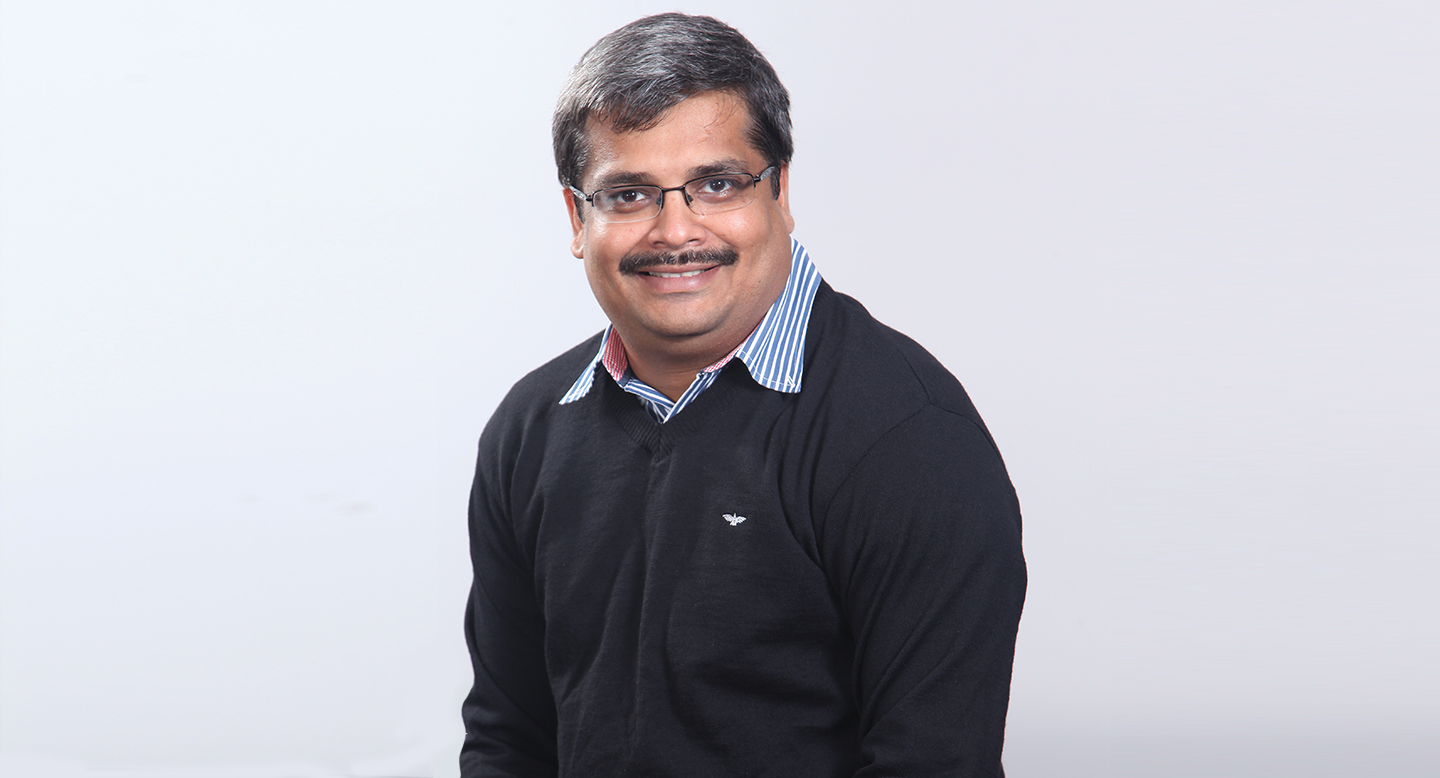Dilipkumar Khandelwal, Managing Director, SAP Labs India, believes the new normal for large companies like SAP will revolve around the mindset to co-innovate with partners, embrace a startup-like culture and, most importantly, inspire people to work as if it is their own business

Dilipkumar Khandelwal, Managing Director, SAP Labs India, is a hardcore techie at heart. Also holding the additional responsibility of Executive Vice President and Head of Suite Engineering, Products and Innovation, Khandelwal’s daily schedule often toggles between solving technical challenges and pursuing business growth. A self-professed workaholic who spends over 12 hours at work everyday, he says balancing technology and business responsibilities has now become a way of life.
Today, Khandelwal leads a 6,000-people organization that is responsible for playing a crucial role in SAP Labs’ next phase of growth. “We’re laser focused on contributing to our mission of becoming the cloud company of the future, with a deep focus on the S/4 HANA platform,” says Khandelwal. Of course, globally, SAP is the market leader in enterprise application software serving over 291,000 business customers, and SAP Labs’ India team is responsible for working with teams in Germany, North America and Europe to build up its product mix for the future.
“The key lesson large companies can learn from startups is this: give your people the freedom to innovate, pay attention to new, emerging business models and co-innovate with partners.”
![]()
The focus areas
The India team is spread across Pune, Gurgaon and Bengaluru, and is the second largest development center outside Germany. The primary focus area is to move all of SAP’s products to the cloud. Comprising of engineering teams and software developers, the key responsibilities for the India team include further developing the S/4 HANA platform, new product development, working on new technologies like cloud, mobility and analytics, maintenance and support of legacy software.
SAP HANA’s USP is its ability to process massive amounts of data without information latency. This was possible because the company managed to solve a key technical challenge by combining database, data processing, and application platform capabilities into a single in-memory platform. SAP HANA finds use across sectors – from manufacturing and defense to aviation and retail – primary serving the real-time analytics needs of its clients.
The concept of “bringing design to software” is not new today, but SAP’s founding team foresaw the usefulness and relevance such a concept could bring to the world of software development years back. In fact, Hasso Plattner, co-founder of SAP, made a personal donation of U.S. $35 million to fund Stanford University’s d.school, now officially called Hasso Plattner Institute of Design at Stanford.’
![]()
Khandelwal believes that while product innovation is critical, the trick to managing large development teams revolves around providing relevant opportunities to them. “It is extremely important to offer space and time for people to generate ideas inside the company, and then giving them the opportunity to build these ideas into a new feature or even a new product, as the case may be,” explains Khandelwal. Encouraging intrapreneurship has now become a key area of emphasis.
Additionally, the leadership team at SAP realizes the importance of partnerships. The SAP HANA platform is built in such a way that partner organizations and startups can build on top of that. Labeled the SAP Startup Focus Program, the company’s structured program offers startups in the big data and predictive analytics space access to various resources. This includes immediate free access to SAP HANA platform on which new applications can be built, access to SAP’s customers for a go-to-market strategy and even access to capital, through the HANA Real Time Fund and SAP Ventures.
Innovating on process
In India, Khandelwal, who is also a member of the Global Leadership Team, is also responsible for driving two key process innovations – using design-thinking principles to solve problems and a structured process of co-innovation with partners.
Design Thinking is a suite of tools, methods and processes, which is used to present new solutions to any kind of challenge. It complements SAP’s existing approaches by focusing on understanding the human side of things — what our technology is and what that means to our customers and in turn, to their customers.
The concept of “bringing design to software” is not new today, but SAP’s founding team foresaw the usefulness and relevance such a concept could bring to the world of software development years back. In fact, Hasso Plattner, co-founder of SAP, made a personal donation of U.S. $35 million to fund Stanford University’s d.school, now officially called Hasso Plattner Institute of Design at Stanford.
Khandelwal explains the concept of design thinking as he sees it. “It is essentially a process for innovation that uses the product designer’s sensibility and methods to match people’s needs. In essence, it refers to a way of building products with a holistic, multi-dimensional approach.”
At SAP Labs India, teams attend structured design thinking workshops, and it is now part and parcel of the new product development process.
Additionally, the company also runs the SAP Co-Innovation lab (COIL). It offers a hands-on environment for SAP, independent software vendors, system integrators and technology partners to work together with customers and build products. Members of COIL have access to a hands-on working environment, where they can collaboratively work on proof-of-concepts.
Typically, this approach to co-innovation is very relevant for partner organizations that are interested in customer-focused collaboration and Khandelwal believes, this mindset to work with partners will become more and more crucial in the future.

Product mix and approach to development
SAP’s approach to product development is right out of the textbook, with a key involvement of customers from the early days. An anchor customer is involved right from strategy formulation, release planning, requirement definition and so on.
Khandelwal is tightlipped about the specific products being developed at the India Labs currently, but gives us a peek into some of its recent efforts. As he emphasizes often, the key efforts revolve around using the HANA platform to build cloud-based products either independently or with partners.
In addition to the usual suspects of social, mobile, cloud and analytics, the company has also made deep investments in the Internet of Things (IoT) space. IoT simply refers to the ability to have regular things or physical objects like washing machines and air-conditioners fitted with sensors, electronics and software, so they become connected devices. In partnership with the Hamburg Port Authority and T-Systems, SAP India Labs worked a project where space constraints in the port was solved using next-generation IoT technology, paving the way for a new era in connected logistics.
Other notable products the India team worked on include SAP FMS (Fashion Management Solution), SAP Commercial Project Management (CPM), SAP Overall Equipment Effectiveness Management (OEE Management) and Visual Manufacturing Planner (VMP).
The Fashion Management Solution was developed through a co-innovation effort with partners in the fashion industry, aimed at solving all kinds of process problems for customers with manufacturing, retail and wholesale operations. The CPM product was aimed at serving customers that worked on customer projects as well as ones that run large capital investment projects. OEE Management is focused on helping manufacturing firms gather data from the shop floor, to measure and analyze plant performance in real time, while the VMP product is used to serve the process of handing over from product design teams to manufacturing teams.
In short, as a market leader in enterprise software, SAP’s products span the breadth and depth of several industries, sectors and business processes. The complexity involved in nurturing large development teams who contribute to a variety of products, is humongous and SAP’s global leadership is laser focused on ensuring this complexity is tackled with ease.
Mindset
Khandelwal explains to us that as a large company, it is extremely important to keep teams focused. Each team has utmost clarity of the problems and solutions it is working on. Khandelwal says, “I am the only working professional in a family where everyone runs their own business. And, this has taught me one key lesson: If everyone works in the company as if it were their own business, there is no looking back.” It is this culture that he wants to inculcate, across the entire organization.
Khandelwal, who often uses his gut to tackle challenges, says, “The key lesson large companies can learn from startups is this: give your people the freedom to innovate, pay attention to emerging business models and co-innovate with partners.”
On a concluding note, he leaves us with this profound statement, which is up for interpretation: “Learn to embrace the wonderful things that are happening outside; After all, you are part of an ecosystem.”

DILIPKUMAR KHANDELWAL
Managing Director, SAP India Labs
Member, Global Leadership Team
KEY FOCUS AREAS:
Ensure the India development teams across Pune, Gurgaon and Bangalore deliver top-quality work on all global projects.
Deliver on the company’s cloud strategy, user experience strategy
Embrace partnerships with other companies, to further build the HANA platform
Investments in Internet-of-Things
Contribute to SAP becoming the cloud company of the future
Inspire his team to work with utmost commitment
Bring in the right set of people for the future
At SAP Labs India since:
March 2001
Interesting Traits:
Comes from a family that has been running a business for over 100 years.
The best advice he’s ever received:
“Work as if it is your own company, wherever you are.”
What does he read?
All kinds of technology-related articles, keeping in touch with the latest
Decision-making style
Fact-based, with gut feeling playing a key role
Products developed at SAP Labs India, in partnership with other locations
Fashion Management Solution (FMS): A solution for the Fashion industry for customers with manufacturing, retail, and wholesale businesses. The solution is based on IS–Retail and SAP’s in-memory database HANA and was developed in partnership with anchor customers from the industry.
SAP Commercial Project Management: Addresses the needs of companies that perform customer projects as well as companies that run large capital investment projects
SAP Overall Equipment Effectiveness Management:
Enables measurement and analysis of plant performance both in real-time and historically. It utilizes common sources of manufacturing data to obtain metrics that enable a firm to measure availability and performance of equipment and the quality of goods produced by that equipment.
Visual Manufacturing Planner (VMP):
A solution to help in the handover from Product Design to Manufacturing. The target users of this solution are the manufacturing planners who need to convert the Engineering Bill-of-Material (EBOM) to Manufacturing Bill-of-Material (MBOM) and Routing keeping in mind the product and the manufacturing facility constraints.
Connected logistics solution using IoT: Delivered by teams in India along with global counterparts, this solution was conceived after extensive development work between SAP, T-Systems and Hamburg Port Authority, to solve space constraints issues at the port.



